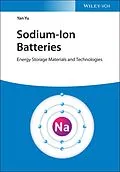Sodium-Ion Batteries
An essential resource with coverage of up-to-date research on sodium-ion battery technology
Lithium-ion batteries form the heart of many of the stored energy devices used by people all across the world. However, global lithium reserves are dwindling, and a new technology is needed to ensure a shortfall in supply does not result in disruptions to our ability to manufacture reliable, efficient batteries.
In Sodium-Ion Batteries: Energy Storage Materials and Technologies, eminent researcher and materials scientist Yan Yu delivers a comprehensive overview of the state-of-the-art in sodium-ion batteries (SIBs), including their design principles, cathode and anode materials, electrolytes, and binders. The author discusses high-performance rechargeable sodium-ion battery technology in the contexts of energy, power density, and electrochemical stability for commercialization.
Exploring a wide range of literature on the recent progress made by researchers on sodium-ion battery technology, the book provides valuable perspectives on designing better materials for SIBs to unlock their practical capabilities.
- A thorough introduction to sodium-ion batteries, including their key materials and likely future developments
- Comprehensive explorations of design principles of electrode materials and electrolytes for sodium-ion batteries
- Practical discussions of cathode materials for sodium-ion batteries, including transition metal oxides, polyanionic compounds, Prussian blue analogues and organic compounds
- In-depth examinations of anode materials for sodium-ion batteries, including carbon-based materials, metal chalcogenides, metal alloys, phosphorus and Na metal anodes
Perfect for materials scientists, inorganic chemists, electrochemists, and physical chemists, Sodium-Ion Batteries: Energy Storage Materials and Technologies will also earn a place in the libraries of catalytic and polymer chemists.
Autorentext
Yan Yu is a Full Professor of material science in University of Science and Technology of China (USTC). Her current research interests mainly include design of novel nanomaterials for clean energy, especially for batteries and the fundamental science of energy storage system. She has published more than 200 articles in international journals. These papers have been cited nearly 10000 times. She has received numerous scientific awards, including the Sofja Kovalevskaja Award of Alexander von Humboldt Foundation and the Wiley Small Young Innovator Award.
Klappentext
This book covers the recent progress of Sodium-Ion Batteries and provides valuable perspectives on designing better materials for SIBs to realize practical applications in the near future.
Inhalt
Foreword
Preface
1 INTRODUCTION TO SODIUM-ION BATTERIES
1.1 Brief Outline
1.2 Key Materials
1.3 Toward Future Development
2 DESIGN PRINCIPLES FOR SODIUM-ION BATTERIES
2.1 Introduction
2.2 Basic Design Principles
2.3 Design Principles for Electrode Materials
2.4 Design Principles for Electrolytes
2.5 Conclusions
3 TRANSITION METAL OXIDE CATHODES FOR SODIUM-ION BATTERIES
3.1 Introduction
3.2 Sodium-Free Transition Metal Oxides
3.3 Sodium-Inserted Layered Metal Oxides
3.4 Concluding Remarks
4 POLYANION-TYPE CATHODES FOR SODIUM-ION BATTERIES
4.1 Introduction
4.2 Phosphates
4.3 Pyrophosphates
4.4 Fluorinated Phosphate Cathodes
4.5 Sulfates
4.6 Silicates
4.7 Other Polyanion-Type Compounds
4.8 Concluding Remarks
5 PRUSSIAN BLUE ANALOGUE CATHODES FOR SODIUM-ION BATTERIES
5.1 Introduction
5.2 Crystal Structure
5.3 Electrochemistry Mechanisms
5.4 Preparation Approaches
5.5 Optimizing Electrochemical Performance
5.6 Concluding Remarks
6 ORGANIC CATHODES FOR SODIUM-ION BATTERIES
6.1 Introduction
6.2 C=O Reaction
6.3 Doping Reaction
6.4 C=N Reaction
6.5 Concluding Remarks
7 INTERCALATION-TYPE ANODE MATERIALS FOR SODIUM-ION BATTERIES
7.1 Introduction
7.2 Carbon-Based Anode Materials
7.3 Titanium-Based Anode Materials
8 PHOSPHORUS/PHOSPHIDE ANODES FOR SODIUM-ION BATTERIES ON ALLOY AND CONVERSION REACTIONS
8.1 Introduction
8.2 Phosphorus Anodes
8.3 Metal Phosphide Anodes
9 METAL OXIDES/CHALCOGENIDES/ALLOYS FOR SODIUM-ION BATTERIES ON ALLOY AND CONVERSION REACTIONS
9.1 Introduction
9.2 Metal Oxides
9.3 Metal Chalcogenides
9.4 Metal Alloys
10 EFFECTIVE STRATEGIES TO RESTRAIN DENDRITE GROWTH OF NA METAL ANODES
10.1 Introduction
10.2 Liquid Electrolyte Optimization for Na Metal Anodes
10.3 Construction of Novel Current Collectors for Na Metal Anodes
10.4 Alloy-Based Na Metal Anodes
10.5 Conclusions
11 ORGANIC LIQUID ELECTROLYTES FOR SODIUM-ION BATTERIES
11.1 Introduction
11.2 Electrolyte Properties
11.3 Sodium Salts
11.4 Solvents
11.5 Functional Additives
11.6 Novel Concentration Electrolyte Systems
12 IONIC LIQUID ELECTROLYTES FOR SODIUM-ION BATTERIES
12.1 Introduction
12.2 The Cationic Species in Ionic Liquids
12.3 The Anionic Species in Ionic Liquids
12.4 Electrolyte Properties
12.5 Stability of Ionic Liquids
12.6 Concluding Remarks
13 SOLID STATE AND GEL ELECTROLYTES FOR SODIUM-ION BATTERIES
13.1 Introduction
13.2 Energy Density
13.3 Electrolyte Characteristics
13.4 Polymer Electrolytes
13.5 Inorganic Solid-State Electrolytes
14 BINDERS FOR SODIUM-ION BATTERIES
14.1 Introduction
14.2 Main Functions and Performance Requirements of Binders
14.3 Polyvinylidene Fluoride (PVDF)
14.4 Polyacrylic Acid (PAA)
14.5 Carboxymethyl Cellulose (CMC)
14.6 Styrene Butadiene Rubber (SBR)
14.7 Other Binders
15 SODIUM-ION FULL BATTERIES
15.1 Introduction
15.2 Aqueous Sodium-Ion Full Batteries
15.3 Non-Aqueous Sodium-Ion Full Batteries
15.4 Solid-State Sodium-Ion Full Batteries
16 PERSPECTIVES FOR SODIUM-ION BATTERIES
